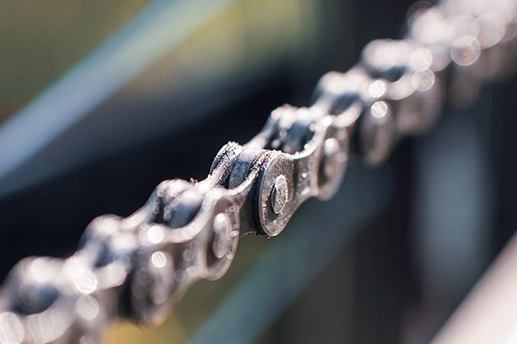3 Signs Your Roller Chain Needs Replacing

Roller chains don’t last forever and knowing when to replace them can save you time, money, and unexpected downtime. By regularly inspecting your chain drives and looking out for key signs of wear or damage, you can stay ahead of failure and keep your operations running smoothly.
Here are the three main indicators that it’s time to replace your roller chain:
Chain Elongation
Over time, roller chains don’t actually ‘stretch’, but they can appear to. That’s because the internal components, like the pins and bushings gradually wear down through regular use. As each individual part loses a fraction of its original size, the accumulated effect across the full length of the chain results in elongation.
Even a small amount of wear - even just 0.25mm per link – adds up significantly over a few metres. This can lead to the chain riding up on the sprocket teeth, increasing the risk of slipping, noise, and accelerated component wear. If your chain starts to look too long for its sprockets or feels slack despite proper tensioning, it’s time for a closer inspection.
Visible Wear or Corrosion
Wear can occur on any part of the chain drive; the chain itself, the sprockets, or both. Look out for:
- Worn rollers, pins or bushings
- Cracked links or rust
- Chipped, hooked or missing sprocket teeth
Excessive noise is another giveaway. Grinding, squeaking, or rattling sounds are all indicators of wear, lubrication issues, or misalignment of sprockets. These issues not only affect performance but can lead to reduced speed or load-handling capacity – both signs that your system is under strain and needs attention.
If your chain’s performance has dipped or if unusual noise has become the norm, don’t ignore it. Chains in poor condition are often working harder than they should, and that takes its toll on other components too.
Not Suitable for the Working Environment
Sometimes, premature wear isn’t just a maintenance issue; it’s a mismatch between the chain and the working environment. If you’re seeing rust or corrosion on chain operating in humid, wet or harsh conditions, it’s a strong sign that a corrosion-resistant or stainless-steel chain like the Renold SDss chain is a better fit.
Likewise, if your chain is wearing out or elongating quicker than expected, it might not be rated for the load or speed of your drive system. This is where talking to an expert can make all the difference. Our Power Transmission Product Manager is here to help you choose the right chain for your conditions, saving you time, cost and stress down the line.
Check out the roller chain range here
How to Check for Roller Chain Wear
Checking for wear doesn’t have to be complicated. With the right tools, it’s a quick and simple job. Using a chain wear indicator allows you to measure the percentage of elongation so you can tell at a glance whether it’s time to replace your chain.
Here’s what to look for:
- Elongation: Most roller chains should be replaced when elongation reaches 0.8% to 1.5%, but always check your manufacturer's guidelines.
- Sprocket fit: A healthy chain should sit snugly on the sprocket. If you can pull the chain away from the sprocket teeth easily, it’s likely worn.
- Sprocket Wear: Check for polished areas on sprocket teeth and for asymmetrical tooth shapes, both are signs of wear.
- Cracking or corrosion: Any visible damage or rust means the chain is compromised and should be addressed immediately.
- Noise or vibration: Excessive noise or vibration can signal worn parts, misalignment, or lubrication problems.
When installing new chain and sprockets, using equipment such as a pulley or sprocket laser alignment tool is essential to ensure proper fit and smooth running. Misalignment is one of the most common causes of premature wear, and one of the easiest to avoid.
Download our Roller Chain Wear Chart to help you diagnose issues and make smart maintenance decisions. Because at ACORN, we believe in keeping your machinery running smoothly for as long as possible.
